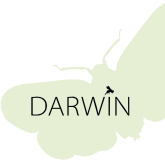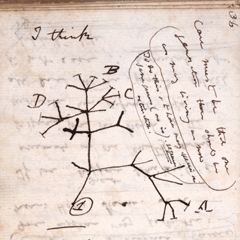
 |
Darwin Day 2014
|
|||||||||||
|
The evolutionary relationship between species on Earth is often depicted as a branching tree. This illustrates the single origin of life, and how new species have evolved into existence at every branching point. But nobody was present to observe which relatives a species actually had when it arose. Instead, zoologists and botanists have grouped species according to anatomical and physiological resemblance, based on the assumption that species that appear similar also are highly related. Over the last couple of decades, our ability to read and understand the genetic sequence has improved dramatically, and in our genes a different story is sometimes written. As we speak, entire branches of the Tree of Life are changing place. Join us on archeological excavations in the genomes! |
 A tree from Darwin's notebooks.
A tree from Darwin's notebooks.
|
Introduction by:
Henrik Glenner
New views on animal evolution
Smmary
The animal part of the Tree of Life has changed dramatically since molecular biology was introduced to the research field about 25 years ago. Molecular disciplines, such as evolutionary developmental biology (EvoDevo) and phylogenomics (DNA sequences from entire genomes), have provided convincing data that puts the branches in new positions. Major animal groups that share a similar anatomy and were thought to be closely related have been split up and moved further apart, while controversial new groups have emerged as new branches. Although the new tree is widely accepted, it has proven challenging to explain how anatomy has evolved in parallel with new branches. This will be illustrated with examples in the talk. Further, the basal part of the tree, which includes sponges, jellyfishes, corals, and comb jellies, is still highly debated, and brand new (and controversial) molecular data suggests that we, once more, might have to revise our view on the evolution of animals.
Andreas Hejnol
Unravelling the evolutionary kinships of animal diversity
Summary
We encounter an amazing animal diversity on this planet. Fascinated by animal documentaries that show behaviour of animals and illustrate recent explorations of the ocean abyss we enjoy this diversity and its beauty. Over 150 years after Darwin's publication of The origin of species researchers are still investigating how diversity on this planet has evolved. Modern technology of DNA sequencing and advances in computational biology allows us to draw a clearer and more detailed picture about how these animals are related to each other and thus allow to trace back the evolution of major organ systems including our brain, digestive tract, and musculature. The findings of these efforts have led to many surprises and unexpected findings. Often against our intuition that everything went from simple to complex, the results sometimes indicate the contrary. However, the research is still ongoing and many questions remain and are hotly debated. I will explain the modern methods used to unravel animal relationships, introduce some of the recent findings and what they mean for our understanding of complexity in general and for the evolution of our own organ systems.
About the Presenters
Andreas Hejnol is group leader at the Sars International Centre for Marine Molecular Biology at the University of Bergen. Together with colleagues he analyses similarities of the genetic sequence and compares embryological development among animal groups to improve our understanding of the evolutionary relationships among them.
Henrik Glenner is professor of marine zoology and group leader for the research group in marine biodiversity, Department of Biology, University of Bergen. Glenner shares with Darwin a passionate fondness of barnacles. Glenenr also does resarch on other crustaceans, with emphasis on their life cycles and phylogenetic relationships. Initially trained in classical morphology, he now regularly involves multple scientific disciplines to address his research questions.
|
Wednesday 12 February 13:00-16:00, Store Auditorium, Haukeland Universitetssjukehus: Lawrence Kirkendall What is Darwinian Medicine, and should it matter to me? Johnny Laupsa-Borge Human nutrition in an evolutionary and bio-cultural perspective
- what kinds of food are we adapted to? Birgitta Åsjö Some evolutionary thoughts on HIV. Click here to read more (In Norwegian). |
Who is behind the Darwin Day in Bergen?
The Darwin Day 2013 in Oslo
Earlier events
2013, 2012, 2011, 2010, 2009, 2008, 2007.
 |
UNIVERSITETET I BERGEN Institutt for biologi |